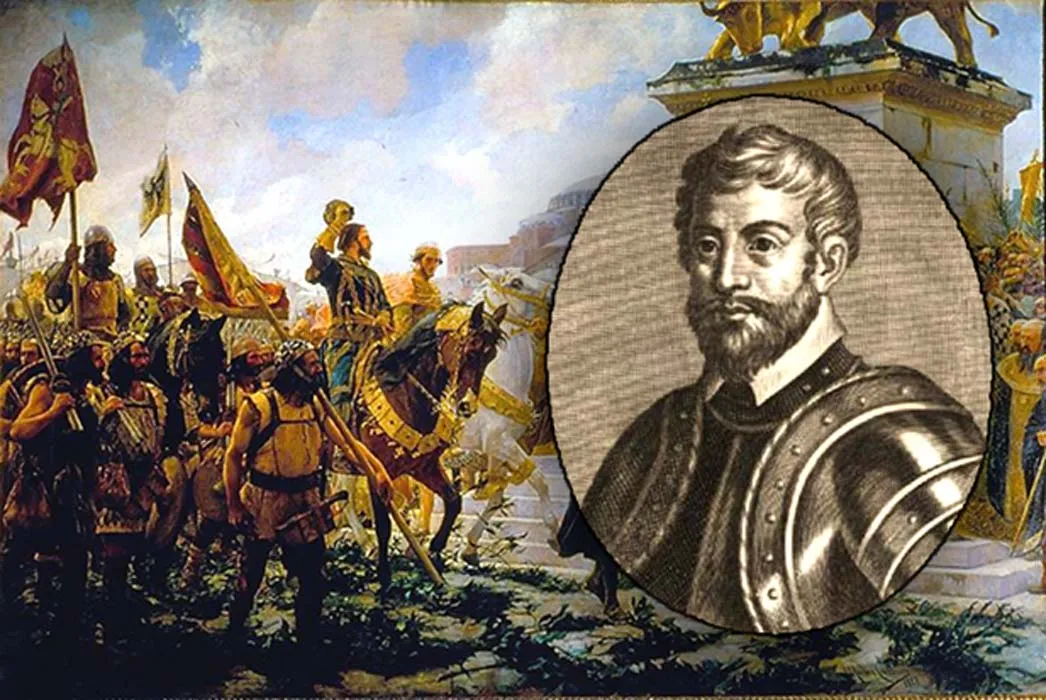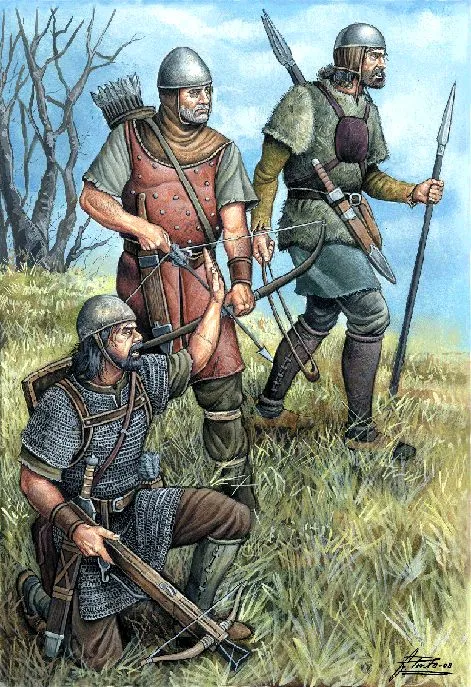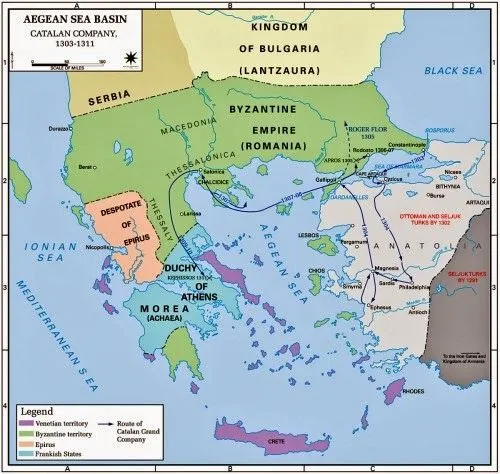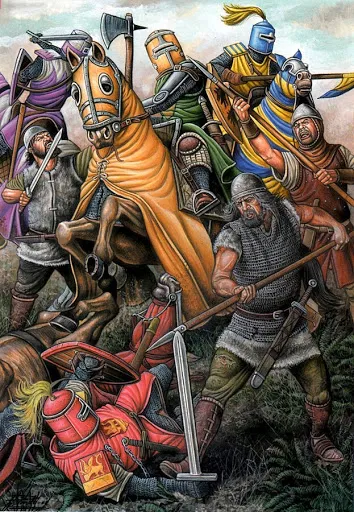The Catalan Company or the Great Catalan Company was a company of mercenaries in the early 14th century, they may have been the first true mercenary company in Western Europe.
The Catalan Company was raised in 1281 to fight as mercenaries in the War of the Sicilian Vespers, where the Angevin and Aragonese dynasties fought over the Kingdom of Sicily. When the war ended, 20 years later its commander was Roger de Flor. De Flor was originally a Templar knight, at the fall of Acre in 1291 he became rich using one of the Templar galleys to ferry fugitives from Acre to Cyprus for enormous fees, later he was a pirate before he joined the Catalan Company and worked his way up to command it.

When peace broke out in Sicily the Catalan Company was no longer needed and it's employers stop paying them, faced with this problem the company had to find a new war to fight in. De Flor negotiated a good deal with the Byzantine Emperor, Andronikos II, who desperately needed mercenaries to fight the Turks.
The Great Catalan Company departed from Messina with 36 ships transporting about 1,500 cavalry and 4,000 almogavar foot soldiers who made the core of the army. The word almogavars is a transformation into Catalan from an Arab word, al-mogauar, which means “one who devastates”. They were frontiersmen and foot-soldiers who wore little armour, dressed in skins, and carried the same arms as the Roman legionaries—two heavy javelins (Spanish azagaya, the Roman pilum), a short stabbing sword and a shield.

The Company arrived at Constantinople in January 1303, where it was received by the Emperor and housed in the district of “Blanquerna”. The Emperor arranged the wedding of Roger de Flor to his niece, the 15 year old princess Maria Asanina.
Soon afterwards Andronikos asked the Catalans to go to Anatolia to reinforce Philadelphia, a Byzantine city entirely surrounded by the Turks for some years. In less than 8 days, Roger de Flor and his army destroyed the Turkish site and left nobody alive older than 10 years old. In the next 3 years the Catalans cleaned Greece from Turkish presence.
The successes had inflated the already arrogant De Flor, which lead him to believe he could create his own version of the Byzantine Empire in Anatolia. Needless to say, this put him at odds with the Byzantine Emperor, and eventually led to De Flor's assassination in an ambush in 1305. Roger was slain along with 300 cavalry and 1,000 infantry by the Alans, another group of mercenaries at the service of the Emperor.
The emperor later attacked Gallipoli attempting to conquer the city from the remnants of the Company under the command of Berenguer d'Entença who had arrived with 9 Catalan galleys. The attack was unsuccessful, but it largely decimated the Company. The Company had only 2,500 men left, when Emperor Michael attacked with his 14,000, trusting in his numerical superiority, only to be defeated in Battle of Apros in July 1305
( )
)
After the battle the Catalan Company raided and ravaged the regions of Thrace and Macedonia for the next two years
In 1310, Gautier or Walter V of Brienne, Duke of Athens, hired the Catalan Company to fight the Byzantine Greeks encroaching on his territory. After the Company had successfully reduced his enemies, he attempted to expel the Company from Athens with their pay in arrears. The Company refusal to leave left Walter with no choice but to march out with his army and destroy the mercenaries.
On the 15 March 1311 an army of 700 Frankish Knights, 2,300 cavalry and 12,000 foot soldiers led by Walter V of Brienne, met the Catalan Company of 3,000 of which 500 cavalry. There was also a contingent of 2,000 Turks standing by, to take the side of the winners. The day before the battle, the Company flooded the battle field with the waters of Cephissus (Kiffissos) river, and made it very difficult for the heavy knights cavalry to move, thus becoming prey to the agile and light cavalry of the Company. The Catalans won a devastating victory, killing Walter and almost all of his cavalry.

In a short space of time, the Company assumed not only the control of the Duchy of Athens but extended its dominions to the city of Thebes and the region of Thessaly, converting the latter into the Duchy of Neopatras, where they established themselves as feudal lords. In 1312 they accepted the overlordship of the Aragonese crown of Sicily.
Both duchies remained in the hands of the Great Company as vassals of the Crown of Aragon until the year of 1390, when they were defeated by the Navarrese Company.
Source materials and if you are interested in reading more. :)
https://en.wikipedia.org/wiki/Catalan_Company
http://www.camrea.org/2017/02/13/roger-de-flor-and-his-catalan-company/
http://byzantinemilitary.blogspot.hr/2014/05/the-catalan-company-byzantine.html
Kenneth Fowler, Medieval Mercenaries, 1: The Great Companies. Oxford and Malden, Mass.: Blackwell, 2001